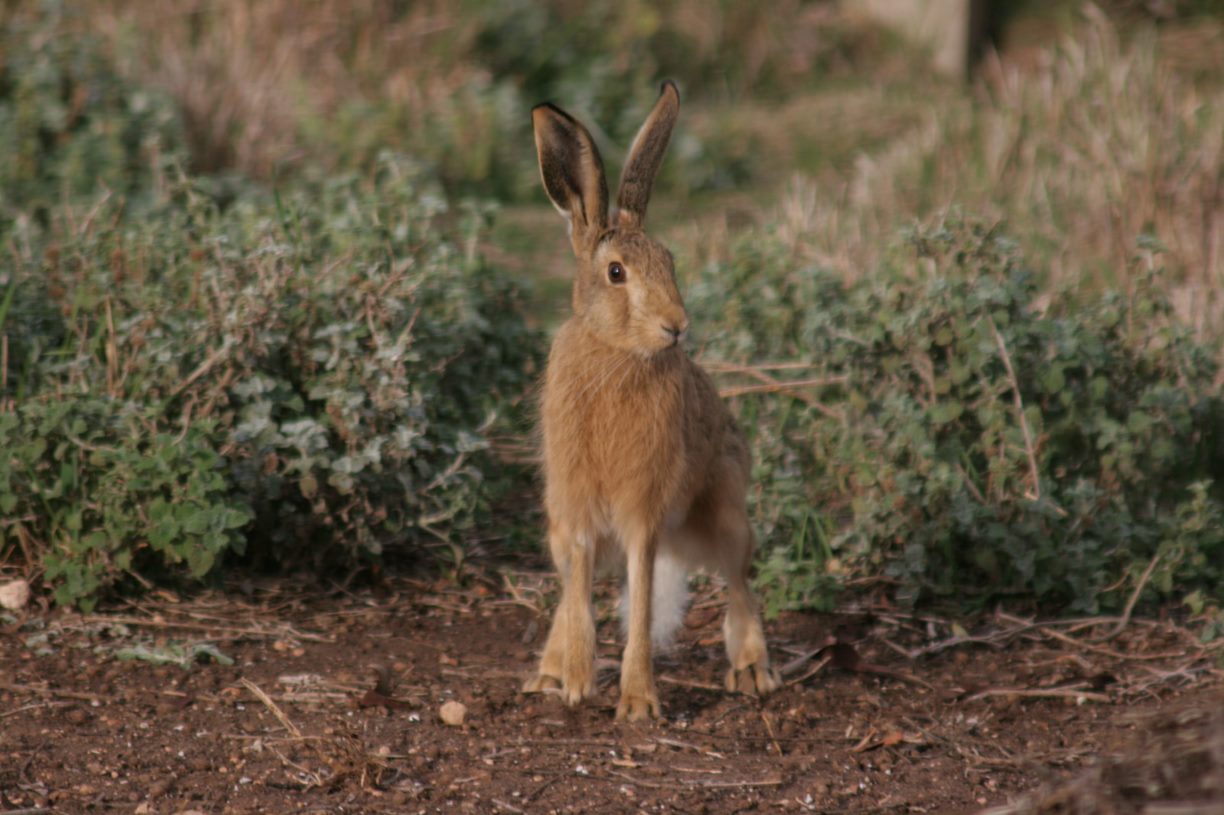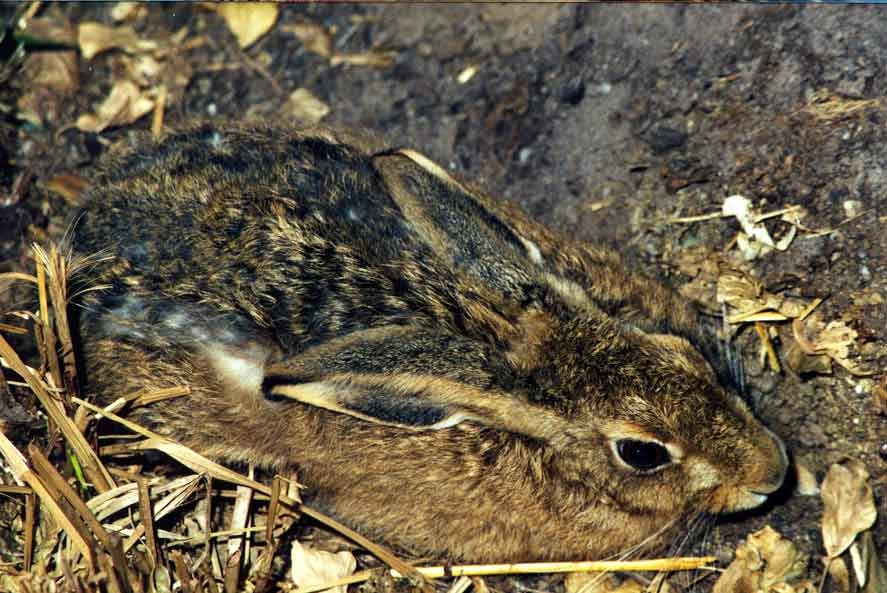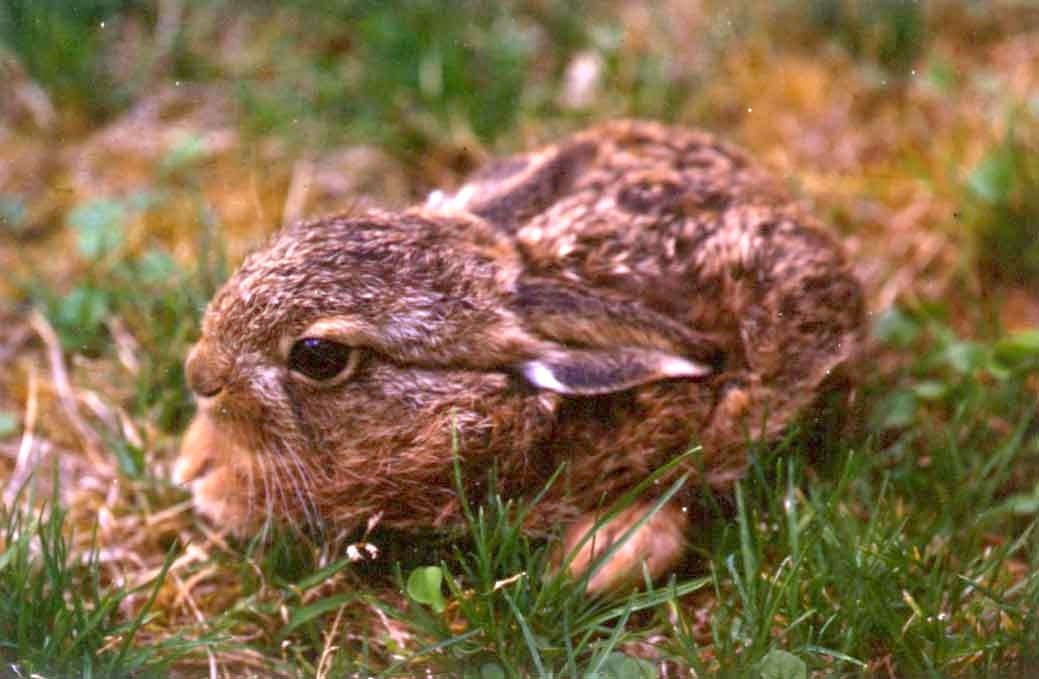European hare
Common name: European hare
Scientific name: Lepus europaeus
Other common name: hare
Origin: Europe and Central Asia

Animal status
European hares are declared as established pest animals in the state of Victoria under the Catchment and Land Protection Act 1994 (CaLP Act).
Read more about the classification of invasive animals in Victoria.
Populations
History of spread
In Australia, the first wild populations of hares occurred on the shores of Victoria's Westernport Bay in 1862. The following year, another hare colony was established on Phillip Island by the Acclimatisation Society of Victoria for the use in the sport 'coursing'. Coursing is where dogs are used to hunt species including hares by sight rather than smell and is an activity regulated by the Codes of Practice under the Prevention of Cruelty to Animals Act (1986) (POCTA).
By 1870, European hares were abundant and widespread throughout much of south-east Australia. Spreading at around 60 kilometres per year, hares had crossed the Murray River by 1875 and had made their way along the western slopes and tablelands of New South Wales. By 1900, hares had reached the Queensland border and become a major agricultural problem in northern and western Victoria now occupying about 700,000 km2.
Distribution in Victoria
Hares are widespread in open grassland, woodland, agricultural and urban areas throughout Victoria.
Animal biology
Appearance
The European hare belongs to the family Leporidae, along with rabbits.
Male European hares are referred to as 'Jack’s' while females are called 'Jill’s'. Offspring under one year are referred to as 'leverets'.
The average weight of an adult hare ranges between 3.5-5.0kg with male hares generally smaller than females. Leverets are born with hair and their eyes open and can move about soon after birth. Like rabbits, juvenile hares have a white star on their forehead.
Hares have large ears which extend past their nose when forward facing. They play an important part in controlling their body temperature. In hot weather, the ears are held away from their bodies to assist with cooling, while in cooler weather they are held close to their body to prevent heat loss.
A hare's hind limbs are longer than its front limbs. The fur has a flecked appearance, made up of tan, black and white hairs, ruddy brown or grey above and white below. This allows them to blend in well with dry grass.
Like rabbits, hares have 28 teeth with the lower tooth rows being closer together than the upper rows. In the upper jaw, hares have 2 pairs of continuously growing, enamel covered upper incisors; the front long pair has a cutting edge, while the peg teeth located behind these do not. This double pair of upper teeth is found only in rabbits and hares and cause a very distinctive, 45-degree angle cut on browsed vegetation. At birth, hares have 3 sets of incisors, but the outer pair is lost soon after.
Behaviour
Hares are most active from late afternoon through until early morning.
Hares are solitary animals but will come together while grazing in response to predation. Their home range average about 149ha, with considerable cross-over between individuals. Hares will travel up to 3 to 4km to feed on a wide range of food types.
Hares can accelerate to high speed when disturbed or threatened. When approached, they will remain still until the predator is within 1 to 2 metres. Then, they will break cover and sprint away from the threat at high speed up to 50km/hr. Hares can also confuse predators by doubling back on its tracks to leave a disarrayed trail. This may also involve a large leap sideways to break the scent trail.
A hare's heart is big for its size, which allows it to run at a pace that many other animals can't match. However, its heart will not support the animal when they are stressed, panicked or traumatised.
Unlike rabbits, hares do not shelter in warrens or burrows. Instead, they rest in a shallow depression in the ground called a 'form'. Forms are usually found among long grass, rocks, logs or branches, oval in shape and around 400mm × 200mm in dimension. Leverets are born above ground into a type of nest created within a form.
Diet
Hares are primarily herbivorous. Their diet consists of leaves, stems and rhizomes of dry and green grasses. They also eat:
- berries
- wood and bark
- seeds
- grains
- nuts
- some fungi
Like rabbits, hares also re-ingest faecal material from the caecum (referred to as caecotrophy) to gain the maximum nutrients from their food.
Preferred habitat
Hares prefer open country with the presence of tussock or rocks to hide amongst. They are widespread in grasslands, woodlands, agriculture and urban areas of Victoria.
Currently, hares are limited to south-eastern Australia's temperate climate which replicates the cool European and Central Asia climates from where they originate.
Predators
Hares are predated on by introduced animals like foxes, feral/domestic cats, and feral/domestic pigs as well as many varieties of native animals like dingoes, quolls, goannas, and wedge-tailed eagles. As they don’t use a burrow for shelter, the adults and leverets are vulnerable, so will spend much of daylight hours resting but alert.
Diseases and parasites
Hares are prone to several different parasites and diseases that can cause higher than normal mortality rates. In Australia, mortality from disease is primarily attributed to RHDV2, a form of the calicivirus which also effects rabbits. Importantly, the RHDV1 K5 strain has never been shown to affect any other species besides rabbits.
Wetter conditions show a trend for higher internal parasite loads for hares in Australia, with several species of parasitic nematodes, coccidian, liver flukes, and tape worms being found to increase during these times.
Several species of external parasites have also been observed on European hares in Australia including the:
- European rabbit flea (Spilopsyllus cuniculi)
- stickfast flea (Echidnophaga myrmecobii)
- lice (Haemodipsus setoni and Haemodipsus lyriocephalus)
- mite (Leporacarus gibbus).
Hares are a known vector for diseases with zoonotic or human health risks. Toxoplasmosis is caused by the parasite Toxoplasma gondii, and when infected hares are predated on by feral or domestic cats, can lead to an increased risk of spread. Therefore, it is important to adopt good hygiene practices when handling hares.
Reproduction
Hares can breed all year, but breeding is often triggered by the availability of high protein green vegetation to stimulate breeding. Hares begin to breed at about 8 months of age and can mate immediately after giving birth.
Under favourable conditions, hares may produce more than 4 litters (each of 2 to 5 young) per year. Research has also shown that the more litters hares have, the smaller the litter sizes become.
The average gestation period for hares is 42 days, but it can range from 38 to 46 days. At birth, leverets are fully furred and are about 13 to 17cm in length weighing 80 to 180g. Their eyes are open at birth, and they can move around soon after. Leverets are born into a form and are hidden within dense vegetation.
The mother will visit to suckle the young once every 24 hours. At around 3 days, the young will disperse from their birthplace and find separate hiding locations. Young from the same litter will return to a central space to suckle. Leverets start to consume solids around day 10 and are fully weaned by around day 35.
Dispersal
Hare home ranges are considerably larger than rabbit home rages at an average of 149ha, with hares being able to travel up to 4 kilometres per night. This is due to their greater mobility and because they do not rely on a warren system for protection from the elements and predators.
Similar species
Rabbits have a similar physical appearance to hares, but hares are larger and have longer ears and longer legs. Generally, hares and rabbits can also be distinguished from each other by the way they run. Hares run with their tails down, and the tail appears black, while rabbits run with their tail up and their tail appears white. Hares eyes have a light brown iris and clear distinction between pupil and iris.
Impact
Impact on ecosystems and waterways
European hares can cause significant damage by gnawing the bark of young trees and shrubs. Hares also chew the stems off young trees, which damages or kills the plant. This makes hare particularly problematic at revegetation sites.
Agricultural and economic impacts
European hares are opportunistic feeders that predominantly graze on grasses, but they also consume crops, such as vegetables, lucerne and cereal. This can cause significant economic losses to landowners. Hares can also travel substantial distances, so the potential for one animal to cause widespread damage to plants is high. European hares can also be a problem in forestry, ornamental and fruit producing plantations as they often gnaw the bark of young trees and vines leading to ringbarking and death of the plant.
Management
Recommended control measures include:
- shooting
- exclusion fencing
- above-ground harbour removal
- use of repellents.
The department recommends integrated pest management using all suitable control measures implemented in a coordinated manner at a landscape scale. Implementing these strategies will have the most impact during late-summer through autumn when the population is at its most stable.
Read more about management and control of European hares.
Further reading
Begnoche, D 2002, Lepus capensis, Accessed online 22 April 2022
Bock.A 2020, Lepus europeaus (Lagomorpha: Leporidae), Mammalian Species, Vol 52, Issue 997. Accessed online 20th October 2023.
Gullan, P date unknown, The other lagomorph (hare-like animal), Accessed online 22 April 2022
Jokelainen. P 2011, ‘Natural Toxoplasma gondii infections in European brown hares…’, Journal of Wildlife Diseases, Vol 4, Issue 1. Accessed online 30th October 2023.
Kuijper, D. P. J, Wieren, S. E. van and Bakker, J. P 2004, 'Digestive strategies in 2 sympatrically occurring lagomorphs', Journal of Zoology, London, vol. 264 part 2. pp. 171 – 178. Accessed online 22 April 2022
Menkhorst, P and Knight, F 2004, The Field Guide to the Mammals of Australia, 2nd Ed. Oxford University Press, South Melbourne, Australia, pp. 212 – 213
Myers, K, Parer, I and Richardson, B. J 1989, Fauna of Australia Volume 1B Mammalia 45. Leporidae, AGPS, Canberra. Accessed online 22 April 2022
Schair-Braun, S, 2021, ‘Maternal effects on reproduction in the precocial European hare (Lepus europeaus), Plos One 16, no 2. Accessed online 23rd October 2023.
Sharp, T and Saunders, G 2004, Standard Operating Procedure HAR001 ground shooting of hares, Policy Document, New South Wales Department of Primary Industries, New South Wales. Accessed online 22 April 2022
Stott. P, 2003, Use of space by sympatric European hares (Lepus europeaus) and European rabbits (Oryctolagus cuniculus) in Australia, Mammalian Biology, Vol 68, Issue 5, Accessed online 2nd November 2023.
Van Dyck, S and Strahan, R 2008, The Mammals of Australia, 3rd Ed. Reed New Holland, Chatswood, Australia, pp. 748 – 749.
Vu, Alan 2008, Lepus europaeus European hare, Accessed online 22 April 2022
Wong, V and Hickling, G. J 1999, Assessment and management of hare impact on high altitude vegetation, Department of Conservation, New Zealand. Accessed online 22 April 2022
Image credits
Figure 1 to 3 courtesy of Phil Stott